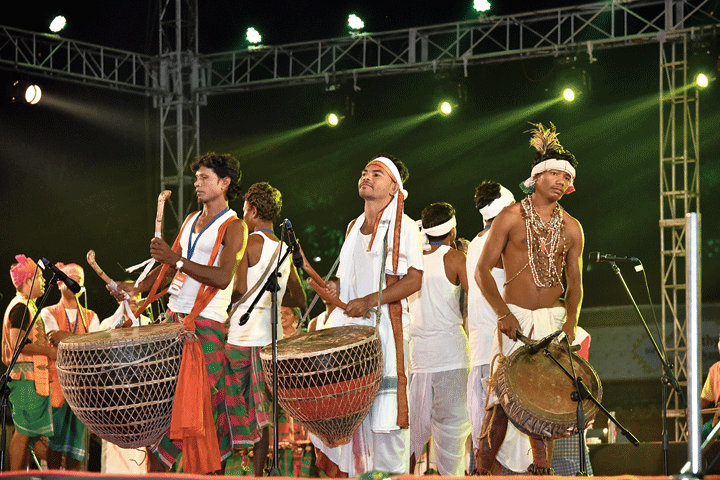The BJP has gone into overdrive to prove that it cares about tribals, including the Centre withdrawing controversial amendments to the Forest Act weeks before the Jharkhand elections, but experts and Opposition leaders say poor implementation has plagued schemes for the indigenous communities.
Tribals make up 26 per cent of the state’s population according to the 2011 census, but experts believe the actual figure is closer to 32 per cent or nearly one-third of the 32.96 million people of Jharkhand.
That the BJP is worried about the tribal vote has been evident, including Prime Minister underlining the link between Lord Ram and tribals during his rally in Gumla on Monday.
State BJP general secretary Dipak Prakash claimed that their party has done what “so-called tribal namesake parties” like the JMM had not even thought of.
“We not only introduced schemes but also ensured that the benefits reach the remotest parts of the state. Since tribals — specially primitive tribal groups — are mostly forest dwellers we accorded top most priority in distribution of forest land rights to tribals. Till 2014, only 18,307 forest land holding rights were distributed while between 2014 and November 2019 we have distributed more than 50,000 forest land holding rights to tribals. We have constituted Jharkhand State ST commission. There has been record of number of residential schools for tribals, ashram schools, sharp increase in food and other expense for tribal students which is borne by the state, sending of scholarship amount directly to individual accounts through direct benefit transfer, etc,” said Dipak Prakash.
The total number of residential school for tribals was 132 in 2015 and in 2019 it has increased to 143, sources in the SC/ST, minorities and backward classes department said.
The Eklavya/ashram vidyalayas have increased from 21 in 2015 to 72 in 2019. The annual allowance for daily food and other facilities has been increased per tribal student of primary schools from Rs 10,300 to Rs 20,000.
The Eklavya residential school is a nationwide programme that aims to provide quality education to tribal children and give them training in sports and skill development.
The institutions also have special facilities for preserving local art and culture.
Similarly, the annual individual allowance for students in middle and high school has been increased from Rs 12,730 to Rs 25,460. In 2014, there was hardly any scholarship amount reaching through direct benefit transfer to students but in 2019 all amounts reach beneficiaries digitally. The government has also introduced incentive of Rs 1 lakh for tribal students who crack UPSC civil service exams for preparation for the Mains and interview.
“We have already been able to get four Eklavya and ashram vidyalayas affiliation from the CBSE and efforts are on to get 14 more schools into the CBSE,” Prakash said. “Our focus has been quality education for tribal students which is reflected on the 90 per cent pass result achieved in matriculation examination earlier this year. Similarly the pass percentage in Class XII for science, commerce and arts streams is 78 per cent, 80 per cent and 94 per cent respectively.”
The BJP leader said that the government has also shown its interest in conservation of the tribal culture.
“We have constructed boundary wall in 2,827 tribal worship places and opened 521 Adivasi Sanskriti Kendras for propagation and preservation of tribal culture and also started providing financial assistance to tribal village heads (Manki Munda, Pahan) in the range of Rs 1,000 to Rs 3,000 so that they get social respect,” said Prakash.
The government has started the process of developing 4,000 villages with 80 per cent tribal population under Anusuchit Janjati Gramin Vikas Yojana (ST rural development scheme). In July 2019 the government started the Targeting the Hard Core Poor Project in which around 2,000 extremely poor families would be brought out of poverty and also started the Dakiya Yojana that aims to provide food to the tribal population at their doorstep.
The government also started the Jharkhand Tribal Empowerment and Livelihood Project in 14 tribal sub plan districts in 169 panchayats of 32 blocks.
“Through this project the government is trying to increase the livelihood of tribal people through animal husbandry, vegetable growth, high-yield agriculture through latest technology and growth of fruit bearing trees. It has touched 1,779 revenue villages across the state,” said a senior official in the welfare department.
However, experts claim that well-intended projects have failed to reach the desired beneficiaries due to poor implementation.
“There are eight particularly vulnerable tribal groups (PVTGs) in Jharkhand — Asurs, Mal, Saharias, Korwas, Birajias, Birhors, Pahariyas, Souriya Pahariyas and Sabars — who depend on forests and the foothills. They live in remote regions and it is difficult to reach these places,” said Asharfinand Prasad of the Jharkhand Right to Food campaign that works on issues related to food security including mid-day meals, anganwadi, pension and maternity entitlements.
“There have been numerous government schemes that have been aimed at bettering the living conditions of the poor and destitute, but the effect of these schemes is not visible within these communities. Either they have not reached to them or they are implemented only partially,” Prasad added.
Jharhand Janadhikar Mahasabha, a coalition of progressive organisations, had pointed out earlier this month that many Dakiya Yojana beneficiaries still had to travel significant distances for collecting ration and the seals of the packets were often found to be broken and some rice missing from those.
Civil society groups like the Mahasabha have repeatedly pointed to problems like attacks on tribal land, deepening divide among Sarna and Christian Adivasis, hunger and under-nutrition, and weakening of the gram sabhas.
JMM general secretary Supriyo Bhattacharya tore into the claims of the government.
“All the claims are on paper. If the government schemes would have been properly implemented then there would not have been more than 18 starvation deaths of poor tribals in the last two years. Most of the tribal hostels are in a dilapidated condition which exposes the real intention of the government towards improving education for tribals. There are no tribal teachers in most of the government schools and the anganwadi centres are not getting their ready to food packets meant for tribal children and mothers due to expiry of contract,” said Bhattacharya.










